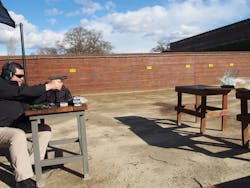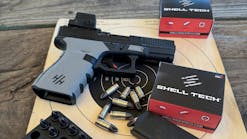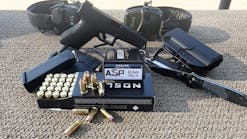Seven 9mm Options That Are Up To The Task
This abbreviated testing included the two factors that most law enforcement officers want to know about their cartridge: bare gelatin performance and after barrier performance. These two factors test the efficacy of a bullet as it is fired into simulated tissue and auto glass.
My friends all know that I have an unusual sense of humor. Occasionally, I will go to a gun store or the range and strike up a conversation that begins with, “The best caliber for a handgun has to be_______”. After that, I just sit back and watch the fireworks begin. It only works on strangers. The truth is, the ability of a cartridge to stop a threat is only a factor, not the factor.
There really isn’t a “best cartridge” for duty use, although some are definitely better than others. Some perform very well in some areas like accuracy, but fail when fired into media. Others do well in some areas, but lack reliability or produce a significant flash at night.
The best cartridges are usually from the companies that vet them in more than just a handful of circumstances. For example, some of the ones I have tested do well in a 4 inch barrel, but if the user uses it in something shorter, the results are disastrous.
Years ago, I tested a cartridge that really performed in standard testing. That is, the bullet penetrated the requisite depth in media, and expanded satisfactorily. It was accurate and reliable. When I shot it in another gun, with a barrel a mere half inch shorter, it failed to expand because it travelled nearly 100 fps slower.
This loss in velocity was a danger to the public. You see, the lack of expansion caused it to travel through two of my blocks (24 inches) and out the other side. Selecting a cartridge is not the goal. Agencies must look at integrated systems.
Ideally, a bullet should penetrate between 12 to 18 inches in ballistic gelatin for maximum performance. Traditionally, full weight retention of the bullet when it comes to rest is considered ideal. Bullet manufacturers use various methods to hold them together, like cannelures, bonding and even epoxy. Most of these methods work. For example, the Hornady, Colt, and SIG SAUER bullets have aggressive cannelures and Hornady even uses an Interlock Band. They stay together, even when fired through barriers. Speer Gold Dot bullets use a bonded core, which produced 100 percent performance in our tests.
I can’t really categorize Liberty Ammunition or G2 Research’s Telos ammunition. They definitely need further testing, but they are both extremely promising.
SIG SAUER Performance Ammunition
SIG SAUER Elite Performance Ammunition 9mm cartridges come in three grains: 115, 124 and 147. All of the SIG SAUER Elite Performance Ammunition 9mm use five skives and scores, which give perfect “flowers” in ballistic gelatin. In our tests, all three cartridge offerings expanded past 150 percent and yielded 100 percent weight retention.
SIG SAUER has made it tough to select a single cartridge for carry. I generally tell agencies to stick with 124 grain bullets, because their velocity is high enough for controlled expansion and the recoil is average across the board. However, the 147 grain bullet was spectacular, delivering 15.7 inches in bare gelatin and 11 inches after barrier. The 124 and 115 grain did 14 inches/10.5 inches and 13.5 inches/12.5 inches respectively. In the after barrier tests, there was slight separation for all three bullets, but the bullets and jackets never completely separated, resulting in full weight retention.
Which one would I recommend for the handgun I used for the test? My FNP-9 preferred the 147 grain. In a separate test, I found that shorter, lighter handguns like the Smith and Wesson Shield do well using the 115 grain cartridge.
Speer Gold Dot G2
Speer uses a 147 grain jacketed bullet with five pre-scored “memory lines.” The hollow cavity is filled with a clear elastomer. It is constructed in two parts, where a lead alloy is bonded to the jacket. The bonded core is designed to prevent separation between the core and the jacket.
The bullets are loaded into nickel plated brass. They expanded exactly along the pre-scored memory lines to just over 150 percent, and fed flawlessly.
In my years of testing, I have never become an advocate for a 147 grain 9mm cartridge. The one reason is the fact that the heavier bullet tends to have more “felt” (subjectively measured) recoil. The other is the fact that they often don’t get enough velocity for consistent expansion. Some users (and agencies) swear by the 147 grain cartridge without ever having testing them in their duty guns.
I don’t do rocket science. I get several blocks of Clear Ballistics gelatin, check them for calibration, and shoot them on the range.
Speer has mastered the art of the 147 grain 9mm with the Gold Dot G2. This is a new bullet. It does what Speer says it does and does what many companies wish their products did.
Major bullet manufacturers have responded by putting their own materials into the hollow point. Speer’s clear elastomer makes the bullet’s expansion consistent, no matter what it encounters. If the bullet is already filled with their material, clogging isn’t a factor.
The G2 is a new design, and it gave consistent expansion in this test. In bare gelatin, it opened up to about 145 percent, with 100 percent weight retention. The penetration depth was 13.5 inches. After barrier was 10.5 inches. It was also one of the most accurate cartridges in this test.
Would I recommend the new Speer Gold Dot G2 cartridge? Yes, without reservation.
It should be clear that this law enforcement cartridge performed well in these tests, but the off duty cartridge in shorter barrel 9mms should be the 124 grain Gold Dot Short Barrel Personal Protection - 9mm Luger +P.
Hornady Critical Duty
Hornady Critical Duty cartridges are also for duty-sized guns. Rather than go with heaver 147 grain or lighter 115 grain bullets, Hornady split the difference and designed a truncated cone, 135 grain, elastomer Flex Tip, FlexLock Bullet. Hornady uses an InterLock band to keep the bullet and core from separating when fired at solid objects.
The 135 bullet was moderate in recoil, and produced a consistently low flash in longer barrels. It travelled 17.75 inches in bare gelatin and 14.5 inches after barrier. It delivered 100 percent weight retention in bare gelatin and zero core separation after barrier.
I have been shooting bullets into ballistic gelatin for about 20 years. Every Hornady cartridge I have tested has been in the top 1 percent of performers, each time I have tested them. The Critical Duty 9mm cartridge is probably the best performers Hornady has offered, which is saying a lot considering Hornady TAP is also in the top 1 percent of cartridges I have tested.
In accuracy tests, Critical Duty and my FNP-9 seemed to get along very well. I could easily get a 15 yard group under 1.5 inches, firing from a rest.
Critical Duty is the law enforcement cartridge. The off duty version is Critical Defense. What’s the difference? Critical Duty has a bullet/powder/ballistic combination designed to allow ideal performance in a duty sized barrel. If used in a shorter barrel, the cartridge may not give ideal velocity and minimum flash.
I can’t beat around the bush here and the numbers don’t lie. I have tested cartridges for 20 years and Hornady cartridges have always been stellar performers.
Liberty Ammunition Civil Defense
Liberty Ammo Civil Defense is a 50 grain lead-free cartridge, whose bullets are primarily made of copper. This is a completely different approach from current cartridges. Lighter bullets generally recoil less, but greater mass will get them through solid barriers.
The greatest advantage of the Liberty Ammunition products is the fact that they are half the weight of competitive products. This makes a difference in standard capacity magazines.
The Liberty 50 grain bullet traveled only a few feet per second shy of the advertised 2,000 fps. It looks like the projectile was designed to break up in its intended target, with the largest part of the projectile delivering the deepest penetration. One section only went 2.5 inches, another went 3 inches. The heaviest portion traveled 10.5 inches in bare gelatin. After barrier, this product put most of the bullets at 3.5 inches.
Liberty Ammunition was easy to shoot. The recoil was very light and they exhibited great accuracy. The cartridges are completely slick feeling, which gave the impression of smooth functioning.
Liberty Ammunition also offers a 55 grain 9mm with similar velocity called National Defense.
G2 Research Telos
The G2 Research Telos cartridge is based on a 92 grain solid copper bullet designed to segment in seven sections. The multi-segmented projectile is machined, rather than molded, which also makes it look a little futuristic. The segments are designed to spread, which quickly dumps the energy of the projectile(s) into the target.
The G2 round divided quickly in gelatin, tangential to its travel. It was very hard to capture in a block. Several times, the segments left the block after 8.5 inches. There is a central projectile, which penetrated at the advertised 10.5 inches plus. Shooting through a barrier had almost no effect on the product. Let me explain: Usually, post barrier results are different, because the bullet behaves differently. This bullet didn’t care what it struck.
The 92 grain projectile cut clean holes on paper, often turning in sub 1 inch groups. This product needs further testing before being sworn in, but it cannot be described in “normal” ballistic terms. On another note, considering what it showed us so far, it may be a great off duty product.
Note to self, send G2 Research an invoice for tearing up my ballistic gelatin.
Colt Defense 124 gr JHP
Colt Defense cartridges are made by DoubleTap Ammunition and marketed under the Colt Defense Ammunition brand. These are 124 grain +P cartridges with external scores on the bullets for controlled expansion. The bullets have a more rounded ogive and the cartridges are loaded into DoubleTap brass. Here’s what I know about DoubleTap Ammunition: They have been the most consistent manufacturers in the industry, with outstanding quality control. These cartridges meet the stringent quality of both Colt and DoubleTap. They also gave consistent performance. In bare gelatin, they penetrated 13 inches, with very aggressive expansion. The wound channel was particularly dramatic. After barrier, the bullets stayed together, reaching 8.5 inches.
Accuracy was better than average, consistently under 2 inches. These cartridges performed the same, shot after shot.
L-Tech Ammunition
L-Tech Ammunition manufactures for several brands, under the parent brand’s name, including some of the best performance ammunition in the industry. They market their own 124 grain cartridge using Shell Shock Technologies brass. The L-Tech cartridge did average in accuracy and muzzle flash. It went to 13 inches in bare gelatin but did not expand after barrier, traveling all the way through two blocks. I have tested this product before, and it did expand before.
This ammunition, not surprisingly, was outstanding in the accuracy category.
Cartridge performance rules
If your agency is thinking of adopting a cartridge, the 9mm is up to the task, as long as the officer adheres to the three rules of cartridge performance:
- Shot Placement
- Shot Placement
- Shot Placement
Editor’s note: Read Lindsey’s Shell Shock Technologies review at Officer.com/12303361.

Officer Lindsey Bertomen (ret.), Contributing Editor
Lindsey Bertomen is a retired police officer and retired military small arms trainer. He teaches criminal justice at Hartnell College in Salinas, California, where serves as a POST administrator and firearms instructor. He also teaches civilian firearms classes, enjoys fly fishing, martial arts, and mountain biking. His articles have appeared in print and online for over two decades.



